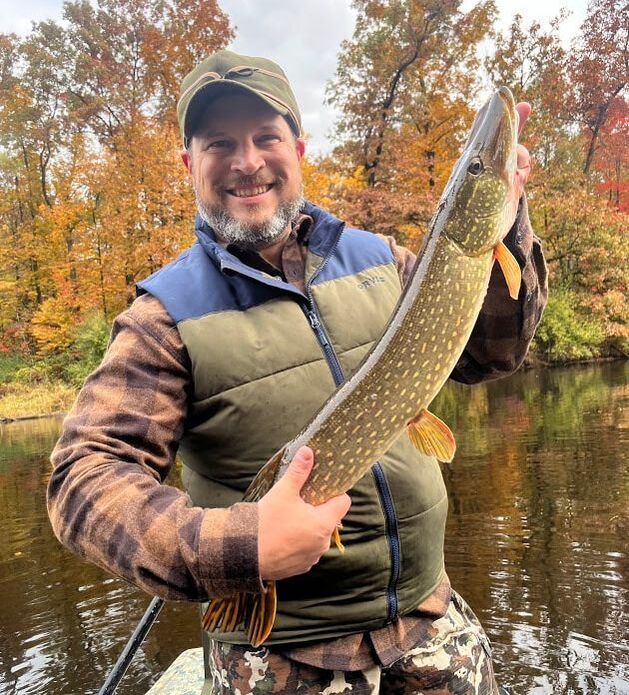|
I’m the first to admit that I’m a terrible angler. I love fly-fishing, but fish do not love my flies. Mostly, as Robert Traver wrote in his Testament of a Fisherman, “I love the environs where trout are found.” Still, it would be nice to actually catch a fish once in a while. Part of my problem, I’m convinced, is that I do not know enough about the science of flies and rivers. So when Jason Frenzel, volunteer coordinator for the Huron River Watershed Council (HRWC), told me about their winter stonefly survey last year, I jumped at the chance to participate.
I’ve devoured books about fly-fishing, but there’s more to learn in a current than on a page. Since moving to Ann Arbor a couple years ago, I’ve fished stretches of the Huron at random, without any clue as to where I should be fishing. The winter stonefly survey appealed to me because it would show me new stretches of water. I would have a chance to scout and learn a little about those waters, and I might even learn a little about flies. Plus, it seemed only right that if I was going to fish the watershed, I should do something to help keep it fishable. Stoneflies are an indicator species, which means that they can only survive in high quality streams. They hide in leaf packs and in gravel bottoms underneath riffles in the winter. Some stonefly species are dormant the rest of the year. The healthy waters which harbor stoneflies also harbor a diverse mix of other flies at other times of the year, like caddisflies, mayflies, and damselflies. I’m no biologist - far from it - but it makes sense to me that an abundance of flies means an abundance of food for fish. My team surveyed two sites in the watershed. The first was Davis Creek, also known as the South Branch of the Huron. The second site was on Greenock Creek. I volunteered to be a “collector,” because it meant that I would be in the water, wading creeks and scooping samples with a net. After training for a couple hours in the morning, I joined my team for the afternoon survey. We also had a team leader and three sorters, all very knowledgeable biology and entomology students from the University of Michigan , Eastern Michigan University, and Oakland University. The first site on Davis Creek was off a dirt road in a wooded area. The only nearby development was a few houses uphill from the creek. I waded in at a shallow gravel point and collected samples from leafpacks under cutbanks, gravel bottoms under riffles, and scraped from fallen logs. The team sorted the samples and found an abundance of stoneflies, as well as mayflies, caddisflies, and larvae. A red-tailed hawk flew overhead, as if to accentuate the natural beauty of the site. The second site provided a stark contrast to the first. Though the creek looked the same, it harbored no stoneflies, and very few of any other fly. This stream intersected a paved road, ran adjacent to a subdivision, and flowed downstream from a dam. Foam collected against a downed tree, and old lumber planks piled atop each other on the far side of the stream, well- hidden in a tangle. On our way back to the vehicle we walked through a swift-moving snowmelt running along the road and bound for the creek. Dams artificially warm water temperatures and trap sediment, decreasing oxygen and reducing the natural flushing action of rivers. Runoff from developments and impervious surfaces carry pollutants, such as phosphorus from lawn fertilizers, directly into the stream, rather than filtering through the ground. Even for someone with my limited scientific background, this site illuminated the damage we’re capable of inflicting on any watershed. Before participating in this survey, I would probably have fished the second site as soon as the first. Except for the aesthetic charm of the South Branch stretch, I wouldn’t have known the difference. Having volunteered, though, I think I’m just a little more knowledgeable about river quality than I was before, and can apply that knowledge to select better places to fish in the future. More importantly, though, hopefully I can use this understanding toadvocate for the improvement of water quality in the watershed and the state as a whole. The HRWC's annual Winter Stonefly Search is coming up on Saturday, January 26, 2013. They're looking for volunteers, so contact Jason Frenzel and let them know you'll be there. You might even learn a little something and catch a few more fish this year! |
AUTHOR
Drew YoungeDyke is an award-winning freelance outdoor writer and a Director of Conservation Partnerships for the National Wildlife Federation, a board member of the Outdoor Writers Association of America, and a member of the Association of Great Lakes Outdoor Writers and the Michigan Outdoor Writers Association.
All posts at Michigan Outside are independent and do not necessarily reflect the views of NWF, Surfrider, OWAA, AGLOW, MOWA, the or any other entity. ARCHIVES
June 2022
SUBJECTS
All
|


 RSS Feed
RSS Feed